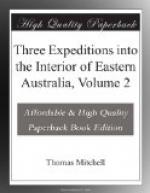DISCOVERY OF THE RIVER YARRAYNE.
Beyond the plain the line of noble yarra trees, which I had observed from Mount Hope, gave almost certain promise of a river; and at 6 1/2 miles our journey was terminated by a deep running stream. The banks were steep and about twenty feet high, but covered thickly with grass to the edge of the water. The yarra trees grew by the brink of the stream and not on the top of the bank. The water had a brown appearance as if it came from melted snow but, from the equality of depth (about nine feet) and other circumstances, I was of opinion that it was a permanent running stream. The current ran at the rate of four chains in 122 seconds, or near 1 1/2 mile per hour; thus it would appear from what we had seen that there is much uniformity in the velocity of the rivers, and consequently in the general inclination of the surface. The banks of this little river were however very different in some respects from any we had previously seen, being everywhere covered thickly with grass. No fallen timber impeded its course, nor was there any indication in the banks that the course was ever in the least degree affected by such obstructions.
A BRIDGE MADE ACROSS IT.
It was so narrow that I anticipated little difficulty in making a bridge by felling some of the overhanging trees. Finding a large one already fallen across the stream where the slopes of the banks could be most readily made passable, we lost no time in felling another which broke against the opposite bank and sunk into the water. No other large trees grew near but the banks were, at that place, so favourable for the passage of the waggons that I determined to take advantage of the large fallen tree; and to construct a bridge by bringing others of smaller dimensions to it, according to the accompanying plan, and not unmindful of the useful suggestions of Sir Howard Douglas respecting temporary bridges.
July 2.
Late in the evening of this day we completed a bridge formed of short but strong sleepers, laid diagonally to the fallen tree which constituted its main support, and the whole was covered with earth from cuttings made in the banks to render it accessible to the carts. At length everything was ready for crossing and we had thus a prospect of being able to advance beyond the river into that unknown but promising land of hill and dale.
COVERED BY A SUDDEN RISE OF THE RIVER.
July 3.
This morning our bridge was no longer to be seen, the river having risen so much during the night that it was four feet under water. Yet no rain had fallen for five days previous, and we could account for this unexpected flood only by supposing that the powerful shining of the sun during the last two days had melted the snow near the sources of the stream. At noon the water had risen fourteen feet. A whispering sound much resembling wind among the trees now arose from it and, however inconvenient to us, the novelty of a sudden rise in the river was quite refreshing, accustomed as we had been so long to wander in the beds of rivers and to seek in vain for water. Our little bridge continued to be passable even when covered with four feet of water but, as it had no parapets, we could not prevent some of the bullocks from going over the side on attempting to cross when it was thus covered.




